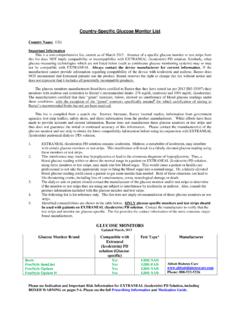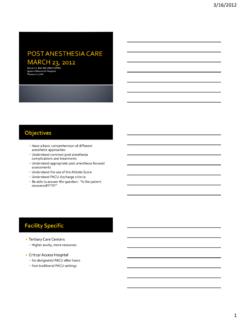Transcription of Value Based Clinical Commissioning Policies North …
1 Value Based Clinical Commissioning Policies North East & Cumbria Clinical Commissioning Groups Version Review: April 2018 Implementation: 1 November, 2017 Value Based Clinical Commissioning Policy Version Page 2 of 52 Contents Introduction .. 4 Frequently Asked Questions (General) .. 5 VBC Checker Frequently Asked Questions .. 7 Individual Funding Request (IFR) Frequently Asked Questions .. 7 Cosmetic Procedures .. 9 Commissioning Responsibility .. 9 Abdominoplasty or Apronectomy .. 10 Autologous Serum Eye Drops .. 10 Bariatric surgery .. 10 Blepharoplasty .. 11 Breast - Asymmetry .. 12 Breast - Augmentation .. 12 Breast Inverted Nipple 12 Breast Mastopexy .. 12 Breast Prosthesis Removal .. 12 Breast Reduction .. 13 Bunions .. 14 Carpal Tunnel Surgery .. 15 Cholecystectomy (for asymptomatic gall stones).
2 15 Circumcision .. 16 Complementary and Alternative Medicines .. 16 Dupuytren s Contracture .. 17 Exogen Ultrasound Bone Healing .. 18 Extracorporeal Shock Wave Therapy for Plantar Fasciitis .. 18 Face Lift or Brow Lift .. 18 Functional Electrical Stimulation .. 18 Ganglia .. 19 Gastric Neuromodulation .. 19 Groin Hernia .. 20 Grommets (and other ventilation devices) in Children .. 20 Gynaecomastia .. 22 Hair Grafting Male Pattern Baldness and Hair Transplantation .. 22 Value Based Clinical Commissioning Policy Version Page 3 of 52 Hip Prostheses and Resurfacing .. 23 Hip Replacement Surgery .. 23 Hirsutism .. 23 Hyperhidrosis Treatment with Botulinium Toxin .. 24 Hysterectomy for Heavy Menstrual Bleeding .. 24 Invitro Fertilisation (IVF) and Intracytlopasmic Sperm Injection (ICSI).
3 25 Knee Arthroscopy .. 30 Knee Replacement Surgery .. 31 Liposuction .. 31 Low (lumbar) Back Pain and Sciatica (radicular pain) .. 32 Low Back Pain - Spinal injections .. 32 Low Back Pain - Radiofrequency denervation (rhizolysis) .. 32 Low Back Pain - Epidural and nerve root injections .. 33 Low Back Pain - Spinal decompression and discectomy (lumbar) .. 33 Low Back Pain - Spinal fusion .. 34 Low Back Pain - Lumbar Disc replacement .. 34 Minor Skin Lesions .. 34 Pinnaplasty .. 35 Removal of Tattoos .. 35 Repair of Lobe of External Ear .. 35 Resperate Device for Hypertension .. 36 Resurfacing Procedures: Dermabrasion, Chemical Peels and Laser Treatment . 36 Reversal of Female Sterilisation .. 36 Reversal of Male Sterilisation .. 36 Septorhinoplasty for nasal deformities .. 37 Surgery for Refractive Error (including Excimer Laser following corneal transplant or cataract surgery) 37 Thigh Lift, Buttock Lift and Arm Lift, Excision of Redundant Skin or Fat.
4 38 Tonsillectomy .. 38 Trigger Finger .. 39 Vaginoplasty, Labial Vulvoplasty and Vulvar Lipoplasty .. 39 Varicose Veins in the Leg .. 39 Document History .. 42 *These procedures are not routinely funded by Commissioners in the North East and Cumbria Value Based Clinical Commissioning Policy Version Page 4 of 52 Introduction Across the country most, if not all, CCGs have a set of Policies and procedures for limiting the number of low Clinical Value interventions. The Audit Commission s report 'Reducing expenditure on low Clinical Value treatments'1 analyses variation on approaches to this work. This approach was Based on the 'Save to Invest' programme developed by the London Health Observatory2 incorporating the 'Croydon List' of 34 low priority treatments.
5 This policy sets out a consistent approach by CCGs across the North East and North Cumbria to stop variation in access to NHS services and allow fair and equitable treatment for all local patients. Revisions to the policy are now managed and co-ordinated by a clinically-led North East Policy Development and Review Group. For clarity there are two differing processes in place to apply for NHS funding for these procedures: VBC Checker This is a web- Based system which enables primary and secondary care clinicians to obtain an instant funding approval where the patient meets the Clinical criteria for the procedure. A patient does not need to follow the Individual Funding Request (IFR) process in these circumstances. Individual Funding Request (IFR) The IFR process is to be used in circumstances when a patient does not meet the Clinical criteria for a procedure as set out in this policy document but can demonstrate exceptionality in accordance with the definition.
6 Exceptionality is defined as: The patient or their circumstances are significantly different from the general population of patients with the condition in question and the patient is likely to gain significantly more benefit from the intervention than might normally be expected for patients with that condition. 1 Reducing expenditure on low Clinical Value treatments. Audit Commission, April 2 Save to Invest: Developing criteria- Based Commissioning for planned health care in London. Malhotra N. Jacobson B. 2007. Value Based Clinical Commissioning Policy Version Page 5 of 52 Frequently Asked Questions (General) Why do we need Policies ? NHS resources come under ever greater pressures each year. Ensuring that treatment and care is focused where it can make the biggest difference is a key part of making best use of these resources.
7 This is a key challenge for all NHS organisations, and a prime focus for Commissioning among CCGs. These Policies help clinicians identify interventions with limited benefit, thereby providing potential for reinvesting elsewhere, where potential benefits are greater. The alternative to having Policies of this kind is to leave each decision to individual GPs, to manage individual dilemmas without guidance and without the context of the health needs of the wider population. The Academy of Medical Royal Colleges has launched a Choosing Wisely campaign ( ) which is aligned to the North East and Cumbria approach to increasing Value and improving population health. At the heart of the Choosing Wisely initiative is a call to both doctors and patients to have a fully informed conversation about the risks and benefits of treatments and procedures.
8 As well as releasing resources for other activities, it says patients should always ask five key questions when seeking treatment. They are: 1. Do I really need this test, treatment or procedure? 2. What are the risks or downsides? 3. What are the possible side effects? 4. Are there simpler, safer options? 5. What will happen if I do nothing? In a study carried out last year, 82% of doctors said they had prescribed or carried out a treatment which they knew to be unnecessary. The vast majority of this group cited patient pressure or patient expectation as the main reason What do these Policies cover? These cover interventions where there is significant risk that patients undergoing them will gain little health benefit. The procedures have low rather than no Clinical Value .
9 Some may be effective, but may have low Value because other (medical) treatments could be tried first. Other effective procedures may provide large benefits for some patients but less to those with few symptoms, where risks and benefits are closely balanced. There are interventions which are effective in some but give no Clinical Value in others. Finally, there are those interventions that whilst effective, are undertaken for primarily cosmetic reasons, which commissioners often consider as providing low Clinical Value . Value Based Clinical Commissioning Policy Version Page 6 of 52 Who are they for? They are to assist clinicians in making referral decisions, where the principal reason for referral is for surgical intervention. They are also to assist providers of treatment and surgical services and are a statement about what the NHS will routinely pay for.
10 How has the policy been compiled and developed? The Policies have been compiled by a group of Clinical decision-makers, GPs, and Public Health specialists, with advice and guidance from Clinical specialists and regional networks. The group has used published evidence and guidance, alongside expert opinion to develop and refine this set of Policies . These Policies are kept under constant review to ensure the Policies are in-line with evidence and best practice. This process is managed and coordinated across the North East and Cumbria to ensure that there is consistency in the Policies and their application. How often will this policy be reviewed? Commissioners plan to review policy content on a bi-annual basis. However, there may be occasions whereby this is more frequent for example upon receipt of new national or local guidance from organisations such as NICE or NTAG.



